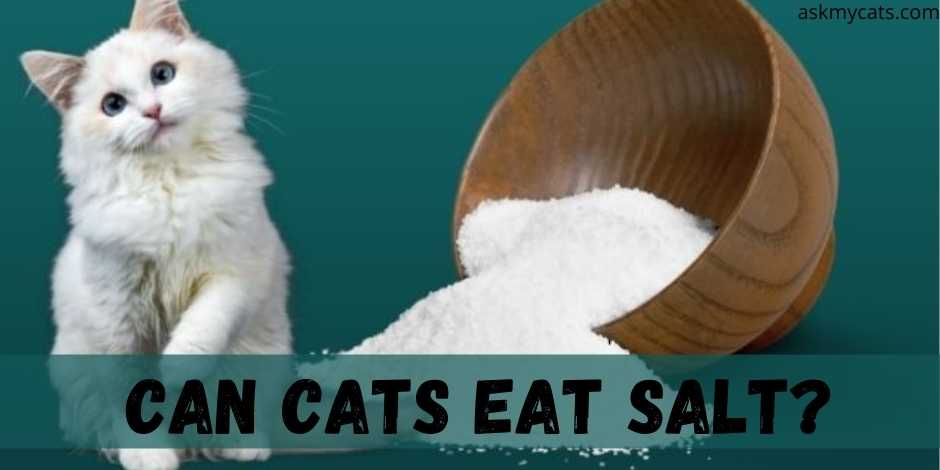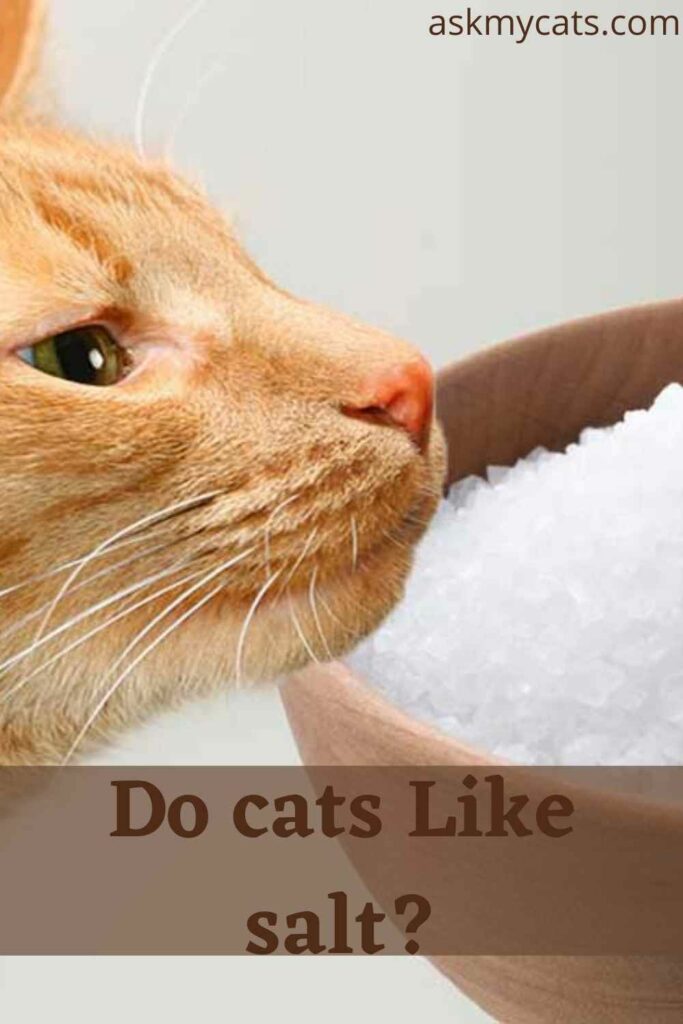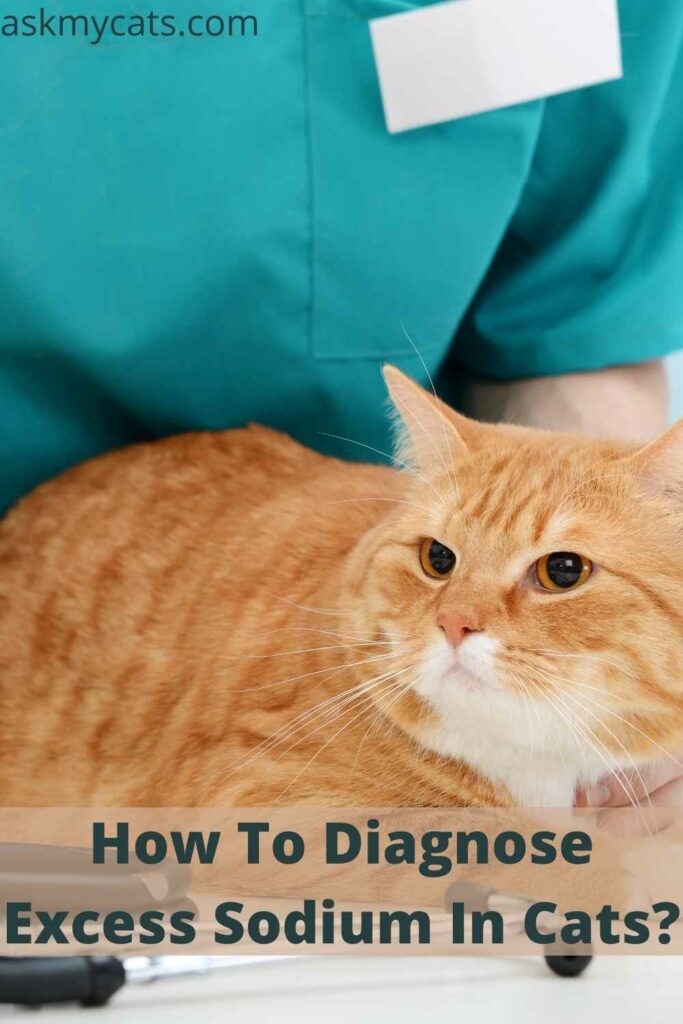Salt is one of those things without which we cannot imagine our food. It is essential for our taste as well as health. But can your feline friend eat salt?
The short answer is No. A modest amount of salt consumption of more than 41mg a day could become poisonous to cats . If she eats salt, she may have any or all of the following symptoms: vomiting, diarrhea, loss of appetite, lethargy, incoordination, and thirst or urine that is excessive.


Give Your Cat the Perfect Day
Get the Free Ebook!
Do cats Like salt?
Yes, many cats like salt and are attracted to salty flavor, being one of the three tastes, they can detect.

Cats are drawn to salty foods and things. They enjoy the flavor and will consider anything salty to be a food source.
This explains why, after crying or sweating, your cat may try to sniff and lick your face.
The necessity for salt in cats’ bodies is one of the reasons for their preference for it.
Cats, like most sentient beings, require salt to keep their body organs functioning properly.
The transport of nutrients in a cat’s bodily cells is aided by salt. It also guides waste materials to the right disposal location.
The safety of salt, on the other hand, will always vary depending on the amount you intend to offer.
So, how much salt does a cat require? According to experts, an average cat only requires 21 mg of salt each day. That’s less than a quarter teaspoon of salt! Larger cats, on the other hand, will require more.
In addition, you’ll note that most cat feeds have a higher salt content. Hidden salts are what you need to seek.
Remember that everything with the word “sodium” on it is a sort of salt that must be factored into your cat’s regular diet.
Always read the label on your cat’s food, especially if he or she has urinary or kidney problems. You should also consider the treats you feed your cat in addition to cat food.
If your cat is at risk of kidney disease, look for low-sodium choices.
Table leftovers should never be given to your cat because they contain too much salt. A single slice of bacon may contain more salt than you think. In the end, your cat will consume more salt than it requires.
Do Cats Need Salt In Their Diet?
Yes, cats need salt in their diet. Dry cat meals should contain at least 0.2 percent salt, according to the Association of American Feed Control Officials, for maintenance and to maintain appropriate growth and development.
Sodium is abundant in meat, poultry, fish, and eggs. It can also be found in commercial cat feeds in the form of table salt, which is occasionally labeled as salt on the ingredient panel. Salt is a vital palatant for both animals and humans.
While excessive salt ingestion might lead to increased thirst and water consumption, the extra sodium is eliminated in cat pee. As a result, in healthy animals, the salt content of conventional pet diets is not a cause for concern.
If a cat has kidney, liver, or heart disease, a veterinarian may recommend lowering sodium intake to help reduce high blood pressure or the accumulation of excess body fluid.
Although older cats are more likely to develop these diseases, they do not require a low- or reduced-sodium diet in order to be healthy.
Can Salt Make Cats Sick?
Salt can make a cat sick if not given in moderation resulting in vomiting, excess urination, lethargy, salt poisoning, and even death.

Too much salt might be harmful to your cat’s health. Their electrolytes become unbalanced as a result of the salt, and their cells refuse to function properly.
Keep an eye out for signs of salt toxicity, such as stumbling, vomiting, diarrhea, and excessive thirst or urination.
If you don’t treat your pet within 24 hours, he could die, so take him to the vet right away if you think he’s had too much salt.
IV fluids and electrolyte balance can be administered by the veterinarian.
Remember that salt can be found in things other than food that your cat eats, such as modeling clay, seawater or water from your saltwater aquarium, or rock salt that sticks to his feet when he walks outside in the snow.
A cat can acquire a condition called hypernatraemia, which is uncommon in healthy animals. This is also known as salt poisoning and refers to an excess of salt in the blood.
It’s unusual for a cat to get salt poisoning only from eating salty foods if it doesn’t have any underlying medical issues.
However, if a cat already has excessive amounts of salt in her blood due to a medical condition, adding more salt to the mix can only make matters worse.
The cat may go into a coma and die if the salt poisoning isn’t treated. Salt poisoning in cats necessitates the assistance of a veterinarian.
A course of intravenous fluids is usually required for the cat. If hypernatraemia is caused by an underlying disorder, it must be addressed as well.
How Much Salt Is Poisonous To Cats?
Salt consumption of more than 41mg a day could become poisonous to cats according to National Research Council.
While salt is often used in the kitchen, it is extremely deadly to dogs and cats. Salt is no longer the standard of care for inducing vomiting in dogs and cats, and it is not encouraged for usage by pet owners or veterinarians!
Salt can also be found in handmade play dough, rock salt (for deicing), paintballs, table salt, seawater, enemas (including sodium phosphate), and other household items.
If left untreated, salt poisoning in dogs and cats causes vomiting, diarrhea, inappetence, lethargy, walking drunk, abnormal fluid accumulation within the body, excessive thirst or urination, probable kidney impairment, tremors, seizures, coma, and even death.
Treatment for salt poisoning includes IV fluids, electrolyte monitoring, dehydration, and brain swelling treatment, as well as supportive care.
What To Do If Cat Consumes Salt Water?
If a cat consumes saltwater, feed your cat fresh water so that the effect can be reduced.
If you took your cat to the beach and allowed it to drink saltwater, you should keep an eye on it for the next few hours. You should also remove your cat from the water as soon as you notice it drinking.
Cats that drank from saltwater pools are in the same boat. A properly maintained saltwater pool usually has a salinity level of around 1/10th that of actual seawater. Nonetheless, it is a source of extra salt that you must be aware of.
Cover your saltwater pool as much as possible to keep your cat from accessing it. You should also have many freshwater bowls around the house so that your cat does not resort to the salty pool.
What Are The Symptoms Of Too Much Salt In Cats?
The symptoms of too much salt in cats include: –
- Weakness
- Anorexia
- Lethargy
- Confusion
- Lack of response
- Vomiting
- Diarrhea
- Dyspnea (labored breathing)
- Head tremors
- Seizures
- Coma
How To Diagnose Excess Sodium In Cats?
To diagnose excess sodium in cats you to go to your vet. They will conduct tests for excess sodium in the blood of cats by drawing blood and performing a hematological assessment.

If you have cause to believe your cat is suffering from an excess of salt, you should seek medical help right once, since this disease can be dangerous and even fatal.
A veterinarian will draw blood and perform a hematological assessment to check for excess salt in the blood of cats.
Your veterinarian will diagnose hypernatremia in your cat if the salt level in his blood surpasses 160 milligrams per deciliter.
Because the signs of excess sodium in cats’ blood are so frequent, your veterinarian may choose a differential diagnosis to rule out other possibilities including electrolyte imbalances or hormone abnormalities.
Other tests may be performed depending on what your veterinarian suspects are causing the excess sodium in your cat’s blood.
To identify diabetes, chronic renal disease, or hormone abnormalities, urinalysis or thyroid hormone testing may be required.
Your veterinarian will be better equipped to treat and prevent recurrence of hypernatremia if he or she can establish the exact cause of your cat’s hypernatremia.
How Do You Treat Salt Poisoning In Cats?
Most cases of salt poisoning in cats are treated with intravenous (IV) fluids to replace water or dilute the sodium in the blood.
Intravenous (IV) fluids will be used to replenish water or dilute the sodium in the blood in most cases of excess sodium in cats’ blood.
This method of restoring sodium balance is extremely safe, effective, and conservative. Your veterinarian’s next line of action will be determined by the underlying reason for your cat’s high sodium levels.
If salt poisoning is suspected, your veterinarian will most likely deliver intravenous fluids to restore sodium-water balance and provide advice on how to avoid future episodes of excessive sodium intake.
Antibiotics may be used if a gastrointestinal illness causes vomiting and diarrhea. Diabetes and chronic kidney illness, for example, will necessitate more intensive therapy and long-term management.
Your veterinarian may offer advice on how to keep this problem from harming your cat in the future. The source of your cat’s hypernatremia will determine how your cat is managed in the future.
If salt poisoning or dehydration is suspected, a veterinarian may advise you to keep fresh water on hand at all times for your cat. It’s also possible to talk about infection prevention, antibiotic therapy, and drug management.
If your cat’s high sodium levels are the result of chronic disease, you’ll need to take further steps to address that condition.
Frequently Asked Questions
Canned food or dry food, which has more salt?
Ans. Dry food is more likely to have more salt when compared to canned food. Salt not only improves the flavor of food but also acts as a preservative. Because salt helps the food keep fresher longer after it’s been opened, dry food is more likely to have a higher salt content than canned food. Canned food should be consumed right away. Because cats obtain a portion of their water from their food, canned food is an important part of their diet.
What is sodium and why is it important for cats?
Ans. Sodium is a mineral that is required for life to exist. Sodium, which is found in the blood and the fluid that surrounds cells, keeps the cellular milieu stable and prevents swelling and dehydration. Sodium is also necessary for the normal function of nerve and muscle cells.
What are salt sources to watch out for?
Ans. Salt sources to watch out for are “people foods” that a cat might consume. Preserved meat, such as jerky or salami, is a common source. Tuna packed in brine is another.
Final Words
It’s advisable to keep an eye on your cat’s salt intake and to respond quickly if symptoms arise. Sodium disorders can be managed with a healthy diet and regular visits to the veterinarian. Most importantly, you should eliminate any excessive salt sources in your home that your cat may have access to.
If you have any unanswered questions, ask away in the comment section.
